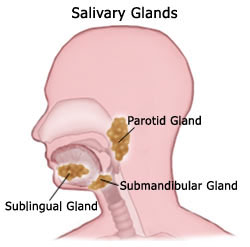SALIVARY GLAND DISEASE

The three major salivary glands in the head and neck are the parotid, submandibular, and sublingual glands. In addition to these major glands, there are over 500 minor salivary glands lining the inside of the mouth. Saliva lubricates the mouth to aid in swallowing, and also decreases bacterial overgrowth, which can lead to tooth decay.
Salivary glands may occasionally become infected. This will present with neck swelling, pain, and pus may drain into the mouth through a salivary duct. Sometimes, a stone in the duct is the cause of the infection. Treatment of a salivary gland infection includes antibiotics, oral or intravenous fluids, salivary gland massage, and heat. Sour candies are also helpful to promote salivation.
Most infections will clear up with medical treatment. If there is a large stone in the duct, or if infection becomes chronic, surgical removal of the involved gland may be necessary.
Cysts and tumors may also arise from the salivary glands. Cysts that form in the floor of the mouth are also referred to as ranulas. They require surgical drainage, usually in combination with removal of the sublingual gland. Salivary tumors may be benign (non-cancerous) or malignant (cancerous). Surgical removal is the main treatment for tumors of the salivary gland. A fine needle aspiration biopsy can be done in the office to help with the diagnosis. If the tumor is malignant, radiation and/or chemotherapy may also be used.
